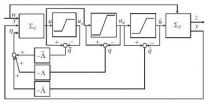(Press-News.org) Treatment with a novel agent that inhibits the activity of SIRT2, an enzyme that regulates many important cellular functions, reduced neurological damage, slowed the loss of motor function and extended survival in two animal models of Huntington's disease. The study led by Massachusetts General Hospital (MGH) researchers will appear in the Dec. 27 issue of Cell Reports and is receiving advance online release.
"I believe that the drug efficacy demonstrated in two distinct genetic HD mouse models is quite unique and highly encouraging," says Aleksey Kazantsev, PhD, of the MassGeneral Institute for Neurodegenerative Disorders, senior author of the study. "The outcome suggests that designing stronger SIRT2 inhibitors is a valid strategy for developing drugs to slow the progression of HD, something that currently does not exist."
Earlier studies by Kazantsev's group and others showed that inhibiting SIRT2 (sirtuin-2 deacetylase) protected against neuronal damage in cellular and animal models of HD and Parkinson's disease – both of which are characterized by the buildup of abnormal proteins in the brain – and in other neurodegenerative disorders. The current study was designed to evaluate in two mouse models of HD use of a new, brain-permeable SIRT2 inhibitor called AK-7, first identified by members of the MGH team in 2011. One model called R6/2 is characterized by robust progression and severity of neurological symptoms. The other, called 140 CAG Htt knock-in, is genetically closer to the human disease. In both models, the mutated huntingtin gene contains extended repeats of the nucleotide triplet CAG, leading to development of HD-like motor symptoms and the same type of brain damage seen in the devastating neurological disorder.
Animals from both strains received two daily injections of AK-7 at one of three dose levels – 10, 20 or 30 mg/kg – beginning at the age of 4 weeks and continuing for up to 14 weeks. Among the R6/2 animals, those treated with AK-7 retained significantly more motor function than did untreated animals and had less shrinkage of brain structures affected by HD and smaller aggregates of the mutant huntingtin protein characteristic of the disorder. Treated animals in this model, which usually die prematurely, lived 13 percent longer than untreated R6/2 mice.
In the experiments with the 140 CAG Htt knock-in model, treated animals maintained activity levels similar to those of normal mice for several months, while untreated mice showed a rapid decline in motor activity. In that model, 14 weeks of treatment reduced mutant huntingtin aggregates in the most affected area of the brain by more than 50 percent, compared with untreated animals from the same strain.
"The golden rule in the HD field for identifying compounds that could work in patients is showing efficacy in a robust HD model like R6/2 and in the more genetically accurate to human disease 140 CAG Htt knock-in model," says Kazantsev, an associate professor of Neurology at Harvard Medical School. "The next essential and critical step will be testing additional, structurally diverse SIRT2 inhibitors in HD mice, and we are preparing to test one that is 10 times more potent than AK-7. If and when that compound and others also show efficacy, that will give us definitive proof of the therapeutic potential of SIRT2 inhibition for HD."
INFORMATION:
Vanita Chopra, PhD, MGH Neurology, is lead author of the Cell Reports paper. Additional co-authors are Luisa Quinti, PhD, Lorraine Vollor, K. Lakshmi Narayanan, and Steven Hersch, MD, PhD, MGH Neurology; Jinho Kim, Christina Edgerly, Patricia M. Cipicchio, Molly A. Lauver and Robert J. Ferrante, PhD, University of Pittsburgh; and Richard B. Silverman, PhD, Northwestern University. The study was supported by National Institutes of Health grant 1U01NS066912-01A1.
Massachusetts General Hospital, founded in 1811, is the original and largest teaching hospital of Harvard Medical School. The MGH conducts the largest hospital-based research program in the United States, with an annual research budget of more than $750 million and major research centers in AIDS, cardiovascular research, cancer, computational and integrative biology, cutaneous biology, human genetics, medical imaging, neurodegenerative disorders, regenerative medicine, reproductive biology, systems biology, transplantation biology and photomedicine. In July 2012, MGH moved into the number one spot on the 2012-13 U.S. News & World Report list of "America's Best Hospitals."
END
Researchers have defined the gene responsible for a rare developmental disorder in children. The team showed that rare variation in a gene involved in brain development causes the disorder. This is the first time that this gene, UBE3B, has been linked to a disease.
By using a combination of research in mice and sequencing the DNA of four patients with the disorder, the team showed that disruption of this gene causes symptoms including brain abnormalities and reduced growth, highlighting the power of mouse models for understanding the biology behind rare diseases.
"Ubiquitination, ...
Economists and professionals praise the merits of competition, as it leads to lower prices and improvements in quality. But in the automobile smog-testing industry, competition can lead to corruption and even public health problems, according to research by USC Marshall School of Business Assistant Professor of Management Victor Bennett.
Bennett, along with colleagues Lamar Pierce of Washington University's Olin School of Business, Jason Snyder at the UCLA Anderson School of Management and Michael W. Toffel of Harvard Business School, found that the structure of the smog-testing ...
PASADENA, Calif., Nov. 29, 2012 – Immunizing older adults with the tetanus-diphtheria-acellular-pertussis vaccine (Tdap) to prevent pertussis (more commonly referred to as whooping cough) was found to be as safe as immunizing them with the tetanus and diphtheria (Td) vaccine, according to a study by Kaiser Permanente published in the journal Clinical Infectious Diseases.
Researchers examined the electronic health records of nearly 120,000 people ages 65 and older at seven U.S. health systems between Jan. 1, 2006 and Dec. 31, 2010. The study looked at a number of medical ...
Actuator saturation is ubiquitous in engineering systems. Anti-windup approach to dealing with actuator saturation has been receiving considerable attention from both the industry and the academic community during the past decades. Professor Zongli Lin and his student Xiongjun Wu developed a new anti-windup design paradigm that is capable of achieving significantly improved performances of the resulting closed-loop system. Their work, entitled "Design of multiple anti-windup loops for multiple activations," was published in SCIENCE CHINA Information Sciences, 55(9), 2012. ...
The detection and recognition of an object with small RCS, such as a stealth target, is the most difficult problem to solve for the modern radar system. Professor Hu Cheng and his group at Radar Research Lab, Beijing Institute of Technology set out to tackle this problem. After seven years of innovative research, they have developed a series of methods to detect, track and recognize some targets with small RCS. In particular, they proposed a novel imaging method based on the principle of shadow inverse synthetic aperture radar (SISAR) to extract the target profile accurately ...
The use of technology in the classroom is nothing new, but Topcliffe Primary School in Birmingham is breaking new ground by using technology to help pupils with autism communicate more effectively.
The school, which teaches around 30 children with various levels of autism, was one of four schools across UK, which participated in the ECHOES research project, jointly funded by the Economic and Social Research Council (ESRC) and the Engineering and Physical Science Research Council (EPSRC) from universities across the UK to explore how technology can make a difference in ...
Together with the Basque R+D centre's researchers, the group of advisers is made up of researchers from the Spanish Institute of Oceanography (IEO), the French Institute for Exploration of the Sea (IFREMER), the French Institute for Research for Development (IRD),and the Portuguese Institute for Fisheries and Sea Research (IPIMAR).This work comes within the 'European Community's Action Plan on Sharks' which has funding from the European Commission's Directorate-General for Maritime Affairs and Fisheries, and is set to take 15 months.
Shark are caught with fishing gear ...
Philadelphia, PA, November 29, 2012 – A potential new therapeutic strategy for treating Fragile X syndrome is detailed in a new report appearing in the current issue of Biological Psychiatry, from researchers led by Dr. Lucia Ciranna at University of Catania in Italy.
Fragile X syndrome (FXS), the most common heritable form of autism and intellectual disability, is one of the most exciting areas in brain research at the moment.
A decade ago, Dr. Mark Bear and his colleagues discovered that an animal model for FXS was associated with a distinctive alteration in brain ...
The wing of a fruit fly may hold the key to unraveling the genetic and molecular events that transform a normal cell into a cancerous one. The study, conducted on Drosophila melanogaster by scientists at the Institute for Research in Biomedicine (IRB Barcelona) and led by ICREA researcher Marco Milán, has reproduced each of the steps known to take place when a healthy cell turns cancerous. The researchers have thus provided an inexpensive and effective model that will allow the scientific community to scrutinize the genes and molecules involved in each step. Given that ...
EAST LANSING, Mich. — Homicide moves through a city in a process similar to infectious disease, according to a new study that may give police a new tool in tracking and ultimately preventing murders.
Using Newark, N.J., as a pilot case, a team of Michigan State University researchers led by April Zeoli successfully applied public health tracking methods to the city's 2,366 homicides between 1982 and 2008. They found the killings were not randomly located but instead followed a pattern, evolving from the city's center and moving southward and westward over time.
Like ...



